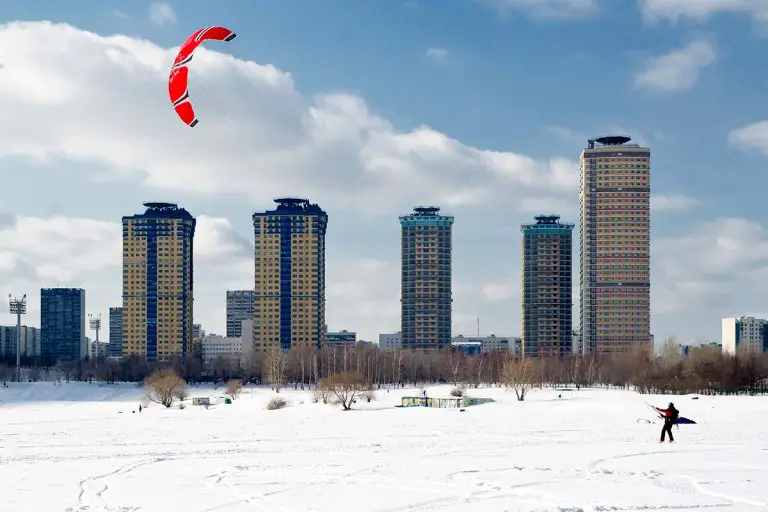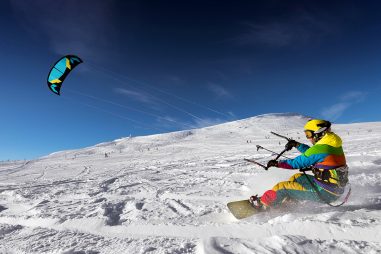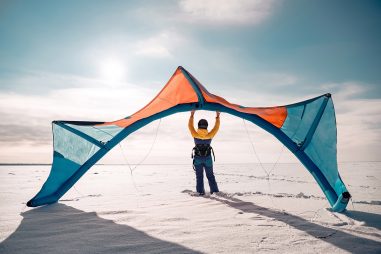Snowkiting offers more than endless adrenaline. Being at snowkiting locations can be an adventure in itself. The endless terrains, the backcountry charm, and isolation add to the allure that the sport has.
And there are numerous snowkiting locations all over the world, each with its unique beauty. If you’ve been planning to try the sport, you won’t go wrong with the best snowkiting locations the world has to offer.
Where Is Snowkiting Popular?
Snowkiting is gaining a huge following all over the world, but most especially in Europe. The continent has the most snowkiting locations across different countries. In North America, snowkiting locations can be found in Canada and the US.
Here are some of the countries that have great snowkiting locations:
- Finland: Lathi is one of the country’s most popular winter sports destinations for snowkiting. If you prefer riding in the mountains, Lapland is the place to be.
- Norway: The country has plenty of wide-open landscapes ideal for a snowkiting holiday. The Hardangervidda Mountain Plateau is probably the most famous.
- Sweden: During winter, Sweden’s frozen lakes and rivers offer plenty of space for riding. You can find them in Stockholm or take the off-beat route and explore the wilderness of Skäckerfjällen or Storlien.
- Switzerland: Considered as one of the best places to snowkite, Switzerland is abundant with lakes and mountain passes for you to fly and ride. These well-known destinations are easily accessible from major cities.
- Russia: The country’s most famous snowkiting spot is Mogoochi‘s Snowkite Park where you’ll find an endless flat surface thanks to a huge frozen lake and unlimited powder snow. The pros need not worry as the park also has obstacles for the more skilled riders.
- Iceland: True to its name, you’ll find an unlimited amount of space, snow, and ice as you snowkite on glaciers like Langjökull.
- Canada: You won’t run out of frozen lakes and snow-covered fields to fulfill your snowkiting dreams in Canada. What makes it even better is the amazing snow conditions that winter sports lovers go crazy for.
Where to Snowkite in Ontario?
When snowkiting in Canada, Ontario is definitely the place to fly and ride. This Canadian province is home to more than 250,000 lakes, many of which have enough space to give you the best snowkiting experience in the region. And for winter sports experts and enthusiasts, these locations are considered the best in the province:
- Lake Superior: It’s no surprise that you can snowkite at the world’s largest freshwater lake (by surface area). In this location, there are two main spots where you can ride: Mission Island Marsh and Black Bay.
- Whitefish Lake: One of the first lakes to freeze in the winter, it’s called Whitefish Lake because it’s a popular ice fishing area. But it’s also big enough for snowkiting and exploration on the side.
- Lake Nipigon: Often used as a training ground for arctic exploration, you’ll be sure to find snow and thick ice on Lake Nipigon. It’s also a popular destination for locals but you’ll find plenty of space to ride.
- Abram Lake: In Abram Lake, you’ll find solid ice and perfect powder snow. It’s located in Sioux Lookout which has more water than land so you won’t run out of snowkiting real estate come wintertime.
But make no mistake, Ontario offers a lot of snowkiting spots aside from these areas. With the thousands of lakes in the province, there’s going to be enough room for beginners and advanced riders to have a great time.
How Much Wind Is Needed to Snowkite?
The winter wind packs more density so it won’t take a lot for you to start riding. How much speed you need will depend on your snowkite and skill level. But generally, 12 kph is enough for anyone to enjoy the sport.
Naturally, beginners should practice with lower wind speeds. This allows them to learn kite flying and control. Intermediate and advanced riders can ride at stronger wind speeds.
When planning your snowkiting trip, checking the weather report is an absolute must. Knowing the wind conditions will tell you if it’s safe to snowkite or if you need to reschedule to another day.
What Is the Ideal Wind Speed for Snowkiting?
How much power you can harness depends on your kite and your skill level. At any level, you can already enjoy snowkiting with wind speeds of 12 kph, as mentioned above.
But for beginners and their training kites, wind speeds of 10-18kph are ideal to learn how to control the kite and ride safely. As with learning anything new, you need to start slow and ease yourself into the mechanics and techniques. Putting safety measures to heart is also necessary as this will save you from serious injuries or worse.
Meanwhile, expert riders using foil or Leading Edge Inflatable kites can ride safely with wind speeds of up to 50kph. Beyond this, it’s still possible to ride, though this is considered extreme and borderline dangerous. Leave this to the pros.
Beyond 60kph wind speeds, you shouldn’t be snowkiting at all.



